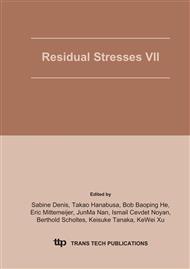p.223
p.229
p.234
p.239
p.245
p.251
p.257
p.263
p.269
Development of New Stress Measurement Method Using Neutron Diffraction
Abstract:
In this study, we proposed the high-versatility stress measurement method using neutron diffraction which can determine the residual stress states by measuring the lattice strains in two or three orthogonal directions even if the measured diffraction families were different in all three directions. In addition, we also proposed the stress measurement method without using the stress-free lattice spacing d0 which was measured using the powder sample or annealed sample. To verify this method, the residual stress distributions in a shrink-fit ring and plug specimen of aluminum alloy A7075 with texture were measured. The profile of the measured stress distributions almost agreed with the simulated stress distributions in the assumption of the plane stress condition. Our method which can determine the tri-axial stress states using observed lattice strains in two orthogonal directions was secondly applied to evaluate the stress states of A7075, high tensile strength steel HT1000, and Ni-base alloy NCF600 loaded in-situ. Measured stresses almost agreed with theoretical value with 10 MPa to 60 MPa error. On the other hand, the residual stress states of NCF600 were measured under the uni-axial loading condition by the stress measurement method without using the measured d0. Estimated lattice constant a was almost agreed with the lattice constant of its annealed sample, and changes in stress states evaluated using the proposed method coincided with the theoretical value.
Info:
Periodical:
Pages:
245-250
Citation:
Online since:
July 2005
Price:
Сopyright:
© 2005 Trans Tech Publications Ltd. All Rights Reserved
Share:
Citation:


